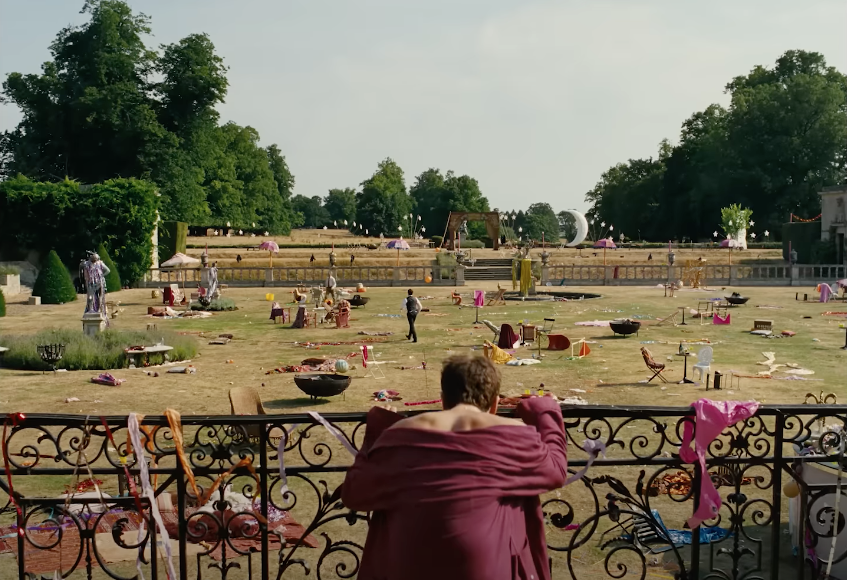interviews
The Cost of Achieving the Indian Dream
Pankaj Mishra's novel "Run and Hide" depicts the relentless drive for self-advancement in the new India

Pankaj Mishra’s return to fiction, Run and Hide, depicts the emotional and social costs exacted by the relentless drive for self-advancement and material progress on the inner lives of individuals as well as nations.
The novel traces the intertwined trajectories of Arun, Aseem and Virendra—three students of the premier Indian Institutes of Technology (IIT), described in the novel as a gateway to the “richness of the world”—whose separate attempts to escape their humble origins mirror the aspirations of Indian society after superpower status in the neoliberal world order of the late 20th and 21st centuries. However, in their eventual failures to escape—and in the damage they inflict on themselves and those around them—Mishra’s characters attest to the degradations visited by the neoliberal order on those left behind, and its fragmentation under the pressures of caste, class, and religion.
Pankaj Mishra brings to the examination of individual lives the trenchant analysis and socio-political awareness with which he dissects the shortcomings of colonialism, capitalism, and neoliberalism in his brilliant nonfiction works, such as From the Ruins of Empire and Age of Anger. In his fiction, this critical analysis is permeated with tender attention to the inner lives of his characters, the details of the everyday degradations they attempt to leave behind, and their complex situations as both agents and victims of progress and its discontents.
I spoke with Pankaj Mishra over email about the human cost of the drive for self-empowerment, and the critical yet compassionate insights afforded by literature.
Pritika Pradhan: Run and Hide is your second novel in twenty years, after several nonfiction books. Could you tell us what inspired your return to fiction? Does fiction, with its close attention to individual lives, enable a different kind of freedom and focus than that of nonfiction?
Pankaj Mishra: Yes, absolutely. I would say fiction enables greater freedom than nonfiction, since your imagination is no longer constrained by verifiable facts and nonfiction protocols. From the time I started out as a writer, I found myself meditating on the role of humiliation in personal and collective lives, and the recourse to pseudo-remedies of self-expansion and ethnic-racial chauvinism. This theme became more and more urgent as the years passed. Today we recognize it in a range of phenomena—from Putin’s assault on Ukraine to the global cultures of inequality and demagoguery.
However, I felt that I had not written or could not write about the way the promise of self-invention, the craving for success, wealth and fame, and the experience of failure and frustration, had decisively altered individual subjectivity. I had written about the role of ideology in public lives, and in politics and economy, but not about the way ideology reshapes private lives, gives fresh content to individual hopes and a new focus to human consciousness. I had written about the new individual freedoms—economic, social, sexual—suddenly available to billions of people, but not about the way the pursuit of those liberations caused fresh losses and traumas. The list of things I had not written about, and which could only be written about in fiction, kept growing and mocking me. At the same time, I was aware that only the form of the novel could unite the intellectual and imaginative modes of comprehension, and I had to go back to it at some point.
PP: Meritocracy and self-advancement take a high moral and emotional toll, from the childhoods lost in pursuit of academic success, to the self-destructive quest for sexual gratification and financial success by Aseem and Virendra respectively. What do their failures reveal about the world they are attempting to navigate?
Much of the disastrous political outcomes that we see today are a result of the promise of meritocracy being revealed as a fraud.
PM: I think that much of the disastrous political outcomes that we see today are a result of the promise of meritocracy being revealed as a fraud. It has become too apparent that those who are wealthy are constantly increasing their wealth and passing on their advantages to family and friends. With the “winners” so clearly taking all, social mobility has been revealed as an illusion. And people who believed in it and sacrificed much for a better future are naturally enraged today. No one wants to be or be seen as a loser. But I had already written about the “left-behinds” and their resentments in my non-fiction. In Run and Hide, I wanted to explore the hidden costs of self-remaking among people hailed as the “winners.” The kind of Indians who run the big tech companies in Silicon Valley and the big banks and hedge funds in London, New York, Berlin and Paris, and who are still deeply marked by their Indian pasts and the wider Indian background that still exists of extreme deprivation.
PP: Arun traces three different paths of escape: Virendra as a billionaire Wall Street hedge fund manager, Aseem as a novelist and leading media personality, and Arun himself as a translator. How do their choices and goals connect and complement each other?
PM: What is common to all three characters in my novel—hedge-funder, magazine editor, literary translator—is not only their background of deprivation, but also their new landscape of endless temptation, which emerged only after 1990, and in which all three men get lost in different ways. I wanted to describe both the great external and internal changes of the last three decades of globalization and, as these characters swam into view, I felt I could achieve at least some of my goals. Virendra, of course, is a recognizable icon of a meritocratic society, though he is still unable to break free of his early experience of degradation. With Aseem, a novelist and host of literary festivals sponsored by oil companies and fashion houses, I wanted to explore how literature, or an idea of literature, came to be implicated in a global Americanized culture whose main self-organizing principles and goals—success, wealth and fame, or intensified communications—have long been explicitly in conflict with art, the life of the mind, and progressive politics. I am haunted by a recent photo in which the feminist writer Chimamanda Ngozi Adichie and Henry Kissinger are bantering at a festival organized by the Financial Times. This confluence of murderous power, mainstream journalism, literary celebrity, and progressive causes is truly unprecedented, and very representative of our age. In this pseudo-glamorous and hectic new setting of global literature, someone like Arun is seen as a kind of failure, a loser, though of course it was through quiet, sustained work of his kind that most writers in the past defined themselves.
PP: In contrast to his batchmates, Arun chooses a path considered economically and culturally marginal, as a translator of Hindi fiction living in a Himalayan village. How does Arun’s work as a translator between languages connect to his role as a narrator and observer of different social contexts across time?
With the ‘winners’ so clearly taking all, social mobility has been revealed as an illusion.
PM: I made Arun a translator rather than a writer for a very specific reason. The translator plays a crucial role in the transmission and reception of literature; this figure is uniquely placed to observe different social contexts while personally remaining invisibly tangential to them. And I think that if you are translating from an Asian language like Hindi, you become aware of the sheer otherness of the experiences—of the caste-shadowed, lower-middle-class, semi-urban lives—that the literature in those languages describes. You also recognize the unassimilable nature of the literature you are translating from, and its great distance from the literature produced in the rich countries of the West. You become aware of the deep intellectual inequality that exists between languages and literatures internationally—an inequality that metropolitan globalizers deepen while claiming, with their literary festivals and international prizes, to forge a “flat world” of “world literature.”
PP: Arun’s life as a translator in a Himalayan village has some similarities with your own experience as a writer who lived in a similar environment for several years. How did your experiences shape your depiction of the lives of Arun and his classmates?
PM: I have become more aware over the last two decades of how different my experience of the world—whether of a Himalayan village or of lower-middle-class austerities and hungers—is from most of my contemporaries in Anglo-American journalism and literature.
I think writers and journalists now tend to live in cities or large towns, or certainly far from villages. Living in a small place, you also come into contact with a wide variety of people from different classes and castes, as well as epochs—so many people in India still inhabit, mentally and emotionally, a pre-modern world. For a writer, such rich and diverse material constitutes a great privilege, and I would like to think that I have used it responsibly.
PP: Gender is also a key marker of difference in your novel. The two main female characters—Arun’s mother, and Alia, the woman he loved—are diametrically opposed in their backgrounds and outlooks, and yet both are damaged by his self-withdrawal. What do their trajectories reveal about the changing spaces for women, and the exploitations and humiliations they continue to face?
PM: In what remains a man’s world, the spaces for women can seem to expand, but this progress can be deceptive. This is certainly true of the two women in my novel. The first—Arun’s mother—is a clear victim of a brutally patriarchal system. The other woman, Alia, is untouched by older oppressions; she is elevated by class and wealth into the progressive global elite. Nevertheless, she remains beholden to men for her identity.
However, I wanted to explore through my male narrator, not so much as gender inequities, as a feeling that many men know and are unable to articulate. At the end of the novel, which is addressed to a woman he has wronged, Arun talks about the “shame” he feels, the “shame of being a man.” The novel is organized as the confession of a male character chastened by his moral failures, around this feeling that I, and many other men I know, often have—of living in and benefitting from a man’s world, of pursuing explicitly masculine goals of power, with often open disregard for other genders, not to mention species, while usually remaining well-positioned to escape the consequences of our actions. Over time, such male privileges begin to seem grotesque—hence the intense but inarticulate feeling of shame.
PP: Run and Hide is rich in literary references, from Chekhov to V.S. Naipaul. Characters read—or misread—literature for guidance in their lives. How does literature, with its possibilities of “subtle perceptions and attentive prose” (to borrow Arun’s words) offer guidance in a rapidly changing and inequitable world?
PM: I think modern literature usurped religion’s role in offering moral and spiritual guidance very early in the 19th century. And it is impossible to deny that great literature expands and sharpens our consciousness of ourselves, other people, and the world at large. This is indeed the great function of literature, if it has any function at all.
However, excess identification with writers or their characters can be harmful—and writers themselves have been alert to this. Flaubert makes the novel’s Madame Bovary reads a dominant influence on her poor choices. In his stories, Chekhov mocks the identification with Turgenev’s idealistic characters that many Russians of his time tended to have. Chekhov is critical, too, of the then flourishing cult of Tolstoy. In our own time, Naipaul, with his myth of the self-invented writer from nowhere, has offered a very seductive model to many readers and writers from the Global South. Of course, there are, in reality, several Naipauls: the productively tormented artist, the ideological journalist, and the puerile provocateur raging against Muslims, women writers and homosexuals.
In my own novel, a misreading of Naipaul’s fiction encourages Aseem into self-aggrandizement. This is because he is looking for clear answers rather than complexly posed questions in literature; he has become blind to the perpetual ambiguity in human affairs that Naipaul, or any great artist, always evokes.









